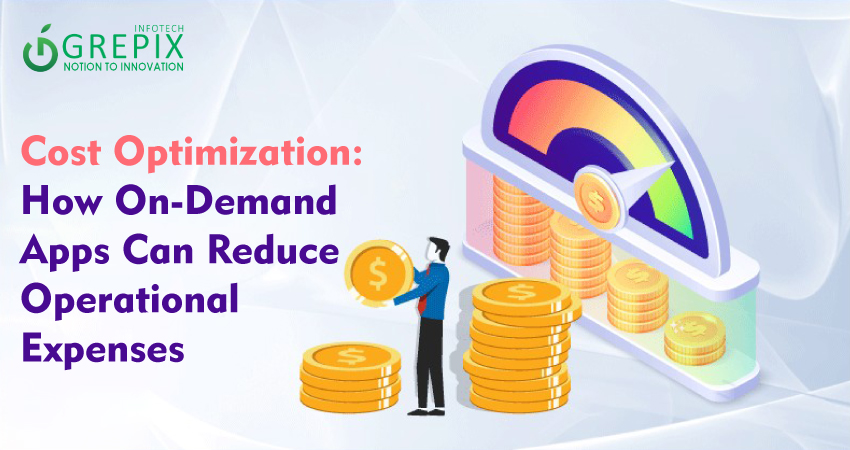Cost Optimization: How On-Demand Apps Can Reduce Operational Expenses
In today’s digital-first economy, businesses are under immense pressure to streamline costs while improving productivity. On-demand apps have emerged as one of the most effective solutions to achieve cost optimization and operational efficiency. From logistics and healthcare to retail and SaaS, companies now leverage technology to reduce app expenses and improve ROI.
This blog explores how on-demand apps foster cost optimization, showcasing actionable tactics, real-life use cases, and technology-driven efficiencies that empower sustainable growth and profitability.
Cost optimization on-demand apps are reshaping how businesses manage expenses and scale efficiently. This blog explores practical approaches that reduce app expenses, enhance automation, and improve resource utilization. From lowering labor costs through AI automation to leveraging outsourcing, companies can save significantly without compromising quality. Real-world examples from Uber, Postmates, and Instacart reveal the proven benefits of adopting technology-driven cost reduction models. Readers will learn how to audit resources, use predictive analytics, and adopt operational efficiency apps that sustain profitability. Whether you're managing logistics, SaaS, or services, on-demand business cost saving strategies ensure better ROI.
1Understanding the Cost Drivers in On-Demand BusinessesM
Cost optimization on-demand apps begin with understanding the key expense sources that impact daily operations. Managing these effectively is critical for improving margins.
- Labor Costs: High manual effort in dispatching, managing orders, or customer support significantly increases expenses.
- Infrastructure and Hosting: Cloud servers, maintenance, and storage can consume 30–40% of tech budgets if unmanaged.
- Customer Acquisition Costs: Marketing spend per customer acquisition can rise without automation or retention solutions.
- Process Inefficiencies: Redundant workflows, unoptimized routes, and delayed decision-making inflate operational costs.
- Technology Debt: Using outdated tools or ignoring integrations intensifies maintenance and scalability issues.
Businesses that prioritize operational efficiency apps can automate repetitive tasks, minimize manual dependency, and reduce app expenses instantly.
2The Role of Automation in Cost Optimization
Automation is at the heart of cost optimization for on-demand apps. By automating key operations, businesses can lower human error, accelerate service delivery, and manage resources more efficiently.
Intelligent Resource Allocation
Automated resource mapping ensures that drivers, freelancers, or service agents are allocated nearest to the customer request, cutting both time and fuel costs.
Chatbots and AI-driven Support
AI chatbots handle up to 80% of repetitive queries, cutting customer service expenses by nearly 30%. This significantly contributes to operational efficiency apps that keep user satisfaction high while minimizing support costs.
Predictive Analytics for Demand Forecasting
Forecasting tools help businesses predict demand trends accurately. This helps reduce wastage, maintain balanced supply, and enhance profitability.
Process Automation in Finances
Automated invoicing, payment reconciliation, and expense reporting reduce financial overheads and minimize administrative strain.
Automation paves the way for measurable on-demand business cost saving, driving both scalability and long-term sustainability.
3Outsourcing and Partnerships: Strategic Levers for Savings
Strategic outsourcing is a tested path toward cost optimization on-demand apps. Partnering with established service providers helps balance quality and cost efficiency.
Benefits of Outsourcing
- Access to Expertise: Eliminates the need for expensive full-time hires.
- Lower Operational Risks: Shared responsibilities reduce management burden.
- Faster Scalability: Businesses can expand to new markets without heavy capital expenditure.
- Cost Transparency: Contracts help maintain predictable budgets.
For instance, DoorDash and Uber Eats partner with multiple local logistics firms to optimize delivery networks without hiring or maintaining their own fleet. This outsourcing move drastically reduces their operational expenditure while improving delivery speeds.
Collaborative partnerships also bring advanced technology and shared data insights, improving total operational efficiency.
4Technology Efficiency: The Backbone of Cost Optimization
Tech stack selection significantly determines how effectively an on-demand app saves money.
Cloud Optimization
Shifting to auto-scalable cloud infrastructure helps balance workloads and prevents resource wastage. Many companies achieve up to 40% cost reduction through managed cloud services.
Microservices and APIs
Building modular architectures allows on-demand apps to scale features independently, ensuring cost-efficient maintenance.
DevOps and Continuous Deployment
Modern DevOps pipelines automate release cycles, minimizing downtime and reducing app expenses associated with manual updates.
Cybersecurity as a Cost Saver
Preventing breaches through proactive monitoring saves millions in potential data loss or compliance fines. Trust and reliability are direct contributors to cost optimization on-demand apps.
Also Read: "User Retention Strategies for On-Demand Apps: Loyalty, Rewards, Personalisation"
5Real-Life Case Examples of Cost Optimization
Uber’s Algorithmic Efficiency
Uber utilizes AI-driven routing algorithms to optimize rides and fuel consumption. This not only enhances customer satisfaction but achieves substantial on-demand business cost saving each year.
Instacart’s Automation Strategy
Instacart employs predictive inventory management. By integrating machine learning with sales forecasting, it reduces wastage by 25%, improving warehouse cost structures.
Postmates’ Fleet Management
Postmates’ operational efficiency apps automatically match couriers with the closest delivery requests, cutting fuel and waiting costs. The company reported a 15% improvement in delivery efficiency post automation.
Gojek's Tech Hub Model
Gojek outsourced parts of its tech stack development to partner teams in Southeast Asia to accelerate updates at a fraction of domestic engineering costs, achieving higher ROI through strategic operational restructuring.
These practical examples prove that cost optimization on-demand apps directly translates to measurable results across supply, logistics, and service networks.
6Key Strategies for Continuous Cost Optimization
- Regular Auditing of Expenses: Monitor recurring costs to identify inefficiencies.
- Adoption of Subscription-Based Tools: Replace legacy software with cloud-based pay-as-you-go models.
- Leveraging Data Analytics: Optimize customer acquisition and predict retention trends.
- Integrating Low-Code Platforms: Accelerate feature releases without expanding developer headcount.
- Energy-Efficient Infrastructure: Prioritize green hosting providers to reduce long-term operational debts.
Every layer of cost optimization should be supported by both automation and data-backed decision-making to ensure ongoing competitiveness.
7Long-Term ROI Benefits of Operational Efficiency Apps
Businesses that deploy operational efficiency apps regularly report:
- Up to 35% savings on administrative tasks.
- 50% faster delivery across fulfillment chains.
- At least 20% higher retention due to consistent user experience.
- Scalable revenue without exponential team growth.
On-demand business cost saving models ensure that enterprises can reinvest profits into innovation instead of immobilized capital costs.
Conclusion
Modern on-demand apps have become powerful enablers of cost optimization. By embracing automation, cloud solutions, and data-driven insights, organizations can meaningfully reduce app expenses and maximize output with fewer resources. Strategic outsourcing, DevOps adoption, and smart partnerships further enhance agility and profitability.
As digital transformation accelerates globally, operational efficiency apps remain central to achieving scalable, sustainable success. Start your cost optimization journey today analyze your workflows, adopt the right tools, and turn operational complexity into measurable savings.
FAQs
1. What is cost optimization in on-demand apps?
Cost optimization refers to the strategic management of resources, automation, and technology integrations that reduce operational expenses for on-demand apps.
2. How can on-demand apps reduce app expenses effectively?
They achieve savings through automation, outsourcing, predictive analytics, and smart cloud deployment that lowers infrastructure and manpower costs.
3. What are the best operational efficiency apps for businesses?
Tools like Slack, Trello, Zapier, and HubSpot help streamline workflows, automate tasks, and maintain cost transparency.
4. How much can businesses save using on-demand business cost saving strategies?
Savings can range from 20% to 45% depending on scale, automation levels, and integration efficiency.
5. What’s the first step in implementing cost optimization on-demand apps?
Start by auditing daily operational workflows and identifying processes that can be automated or outsourced.
Launch your vision with our mobile app development company, where innovation meets excellence to create cutting edge mobile solutions.







